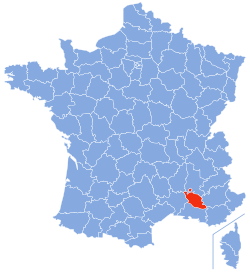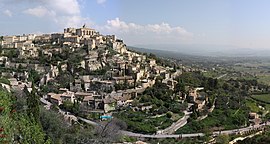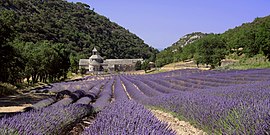Vaucluse
Vaucluse
Vauclusa (Occitan) | |
|---|---|
From top down, left to right: prefecture building and Palais des Papes in Avignon, Gordes (considered one of the most beautiful villages of France), Sénanque Abbey, Sorgue River and Nesque River | |
 Location of Vaucluse in France | |
| Coordinates: 44°00′N 05°10′E / 44.000°N 5.167°E | |
| Country | France |
| Region | Provence-Alpes-Côte d'Azur |
| Prefecture | Avignon |
| Subprefectures | Apt Carpentras |
| Government | |
| • President of the Departmental Council | Dominique Santoni (LR) |
| Area | |
| • Total | 3,520 km2 (1,360 sq mi) |
| Population (2021)[1] | |
| • Total | 564,566 |
| • Rank | 47th |
| • Density | 160/km2 (420/sq mi) |
| Time zone | UTC+1 (CET) |
| • Summer (DST) | UTC+2 (CEST) |
| Department number | 84 |
| Arrondissements | 3 |
| Cantons | 17 |
| Communes | 151 |
| ^1 French Land Register data, which exclude estuaries and lakes, ponds and glaciers larger than 1 km2 | |
Vaucluse (French: [voklyz]; Provençal: Vauclusa (Classical norm) or Vau-Cluso (Mistralian norm)) is a department in the southeastern French region of Provence-Alpes-Côte d'Azur. It had a population of 561,469 as of 2019.[2] The department's prefecture is Avignon.
It is named after a spring, the Fontaine de Vaucluse, one of the largest karst springs in the world. The name Vaucluse itself derives from the Latin Vallis Clausa ("closed valley") as the valley ends in a cliff face from which the spring emanates.
History
[edit]Vaucluse was created on 12 August 1793 out of parts of the departments of Bouches-du-Rhône, Drôme and Basses-Alpes, later renamed Alpes-de-Haute-Provence. The then rural department was, like the nearby city of Lyon, a hotbed of the French Resistance in World War II.
Geography
[edit]
Vaucluse is bordered by the Rhône to the west and the Durance to the south. Mountains occupy a significant proportion of the eastern half of the department, with Mont Ventoux (1,912 m), also known as "the Giant of Provence", dominating the landscape. Other important mountain ranges include the Dentelles de Montmirail, the Monts de Vaucluse and the Luberon.
Fruit and vegetables are cultivated in great quantities in the lower-lying parts of the department, on one of the most fertile plains in Southern France. The Vaucluse department has a rather large exclave within the Drôme department, the canton of Valréas (Enclave des Papes).
Vaucluse is also known for its karst, including the karst spring Fontaine de Vaucluse after which "Vauclusian Risings" are named.
Principal towns
[edit]The most populous commune is Avignon, the prefecture. As of 2019, there are 6 communes with more than 20,000 inhabitants:[2]
| Commune | Population (2019) |
|---|---|
| Avignon | 91,143 |
| Carpentras | 29,236 |
| Orange | 28,772 |
| Cavaillon | 26,236 |
| Pertuis | 20,557 |
| L'Isle-sur-la-Sorgue | 20,042 |
Demographics
[edit]Population development since 1801:
|
| ||||||||||||||||||||||||||||||||||||||||||||||||||||||||||||||||||||||||||||||||||||||||||
| |||||||||||||||||||||||||||||||||||||||||||||||||||||||||||||||||||||||||||||||||||||||||||
| Sources:[3][4] | |||||||||||||||||||||||||||||||||||||||||||||||||||||||||||||||||||||||||||||||||||||||||||
Politics
[edit]Departmental Council
[edit]Following the 2021 departmental election, Dominique Santoni of The Republicans was elected President of the Departmental Council. She succeeded Maurice Chabert, who had held the office since 2015.
The Departmental Council of Vaucluse has 34 seats. The Left Front (FG) currently has 2 seats, the Socialist Party (PS) has 7, Europe Ecology – The Greens (EELV) has 3, the miscellaneous right (DVD) has 2, The Republicans (LR) have 10, the National Rally has 6 and a local party, the Ligue du Sud (LS), has 4.
Parts of this article (those related to the composition of the departmental council) need to be updated. (July 2022) |
Members of the National Assembly
[edit]2022 legislative election
[edit]In the 2022 legislative election, Vaucluse elected the following representatives to the National Assembly:
2017 legislative election
[edit]During the 2017 legislative election, Vaucluse elected the following representatives to the National Assembly:[5]
*On 21 July 2017, Brune Poirson resigned from office to join the Second Philippe government as Secretary of State to the Minister for the Ecological and Inclusive Transition. She was replaced in the National Assembly by Adrien Morenas.
**Jacques Bompard resigned in August 2017 to become Mayor of Orange. He was replaced by Marie-France Lorho.
Tourism
[edit]See also
[edit]- Arrondissements of the Vaucluse department
- Communes of the Vaucluse department
- Cantons of the Vaucluse department
References
[edit]- ^ "Téléchargement du fichier d'ensemble des populations légales en 2021" (in French). The National Institute of Statistics and Economic Studies. 28 December 2023.
- ^ Jump up to: a b Populations légales 2019: 84 Vaucluse, INSEE
- ^ "Historique de Vaucluse". Le SPLAF.
- ^ "Évolution et structure de la population en 2016". INSEE.
- ^ List of members for Vaucluse (in French), on www.nosdeputes.fr.
External links
[edit]- Vaucluse at Curlie
- (in French) Website of the Departmental Council Archived 2018-09-06 at the Wayback Machine
- (in French) Prefecture website














